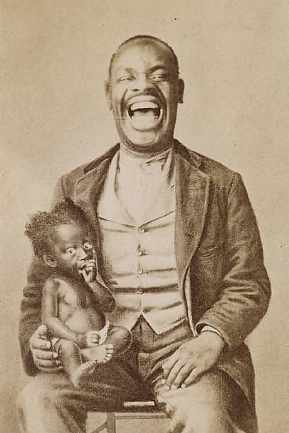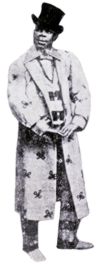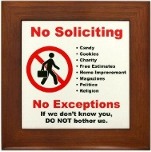|
Billy Kersands was a blackface minstrel and a vaudeville performer who was known for his comedy, dancing, singing, musical performances, and acrobatics. Kersands was about six feet tall and weighed near 200 pounds. He had a large mouth, which he filled with various objects during his stage performances. He was one of the most popular African American entertainers of his time.
Kersands began as a minstrel performer in the 1860s. His exact birth location is not known, but has been given as Baton Rouge, LA. In 1895, Billy Kersands married Louisa Strong in Ascension, LA, and the couple would later own a vaudeville company. Billy Kersands performed with a number of groups, the Charles Hicks Minstrels, the Harvey Minstrels, Richards and Pringle's Georgia Minstrels, and others, including his own company
Kersands' Minstrels, and Louisa and Billy Kersands' vaudeville company. Billy Kersands performed throughout the United States and in England for Queen Victoria.
He was best known and remembered for the size of his mouth, which he would fill with things like billiard balls and saucers for the amusement of the assembled throngs. On the other hand, he is also well revered as a master of early forms of the soft shoe and the buck-and-wing. Dancer, comedian, singer, songwriter, instrumentalist, and acrobat.
He refrained from going into vaudeville (and its greater financial rewards) because he said he had all the money he needed and he was simply more comfortable on the minstrel stage (which was all but gone by the time he passed away anyway)

Billy Kersands traveled across the United States in "a private railway carriage that he purchased
outright." Charles B. Hicks, Kersands's troupe manager with the Original Georgia Minstrels, organized trips to Germany, New Zealand, and Panama to perform.
Billy Kersands was the most popular minstrel star and the highest paid black entertainer of the era, earning as much as one hundred dollars a week---a lot of money in the 1870s and 1880s. Kersands was a comedian who enjoyed entertaining the public. But his real forte was dancing. He was credited as being the first dancer to introduce the "soft-shoe" dance, and the "buck and wing." He was also instrumental in introducing the African-American "clog-dance."
Perhaps the most enduring "mammy"ť icon is Aunt Jemima. Billy Kersands, a black minstrel performer, wrote the song
"Aunt Jemima"ť for a white minstrel artist in 1875. The song was performed in 1889 with a man named Chris Rutt in the audience. Rutt, seeing an opportunity for commercializing the Aunt Jemima character, went on to trademark the name and sold it to The Davis Company. Davis eventually hired a former enslaved woman named Nancy Green to sell their company's pancakes at the Chicago Exposition in 1893. The "mammy" icon of Aunt Jemima has lived far beyond the minstrel song.
He began entertaining in the South, probably before the Civil War and remained a working entertainer for more than 60 years, most of them spent in minstrelsy.
Kersands' popularity with Southern black audiences was unsurpassed, and he demonstrated that a nineteenth-century black entertainer could become rich and famous.
Kersands' most notorious antic was stuffing two billiard balls in his wide mouth as he
performed a monologue: "If God had made my mouth any bigger, he would have had to move my ears."
Perhaps his imposing figure discouraged detractors. He was tall, Weighed well over 200 pounds and carried it well. He dressed as a dandy and wore an oversized cravat with a large stickpin.
Generally forgotten in the obsession with his billiard ball trick is that he was an acrobat of uncommon skill who knew how to use his physical talents for both dancing and physical comedy. He has been credited with devising both the Virginia Essence, a forerunner of soft-shoe dancing, and the buck-and-wing combination.
Such claims can never be substantiated, but it is noteworthy than many dancers of his and the next generation point to Billy Kersands as the man they
first saw doing the Essence or a buck-and-wing. Further evidence is that Billy was known to have performed the Essence in slow 4/4 time to Stephen Poster's melody "Swanee River" music and time still used for dancing the old soft shoe.
Billy Kersands was an all-around talent. He sang, danced, did acrobatics and was both a monologist and a clown. His versatility and his acceptance by both black
and while audiences allowed him to stay abreast of change, and he played minstrelsy, musical comedy and vaudeville. When touring the segregated South in minstrel shows, white theatre managers whose usual patrons were African American met a demand from white people as well as black to see Billy Kersands. The house was divided in hall from the orchestra scats up to the balcony, blacks and whites sat on opposite side; of a center aisle.
Billy began in Negro minstrel shows sometime around the Civil War, certainly he was performing by the start of the war because his skill as a dancer and acrobat have to have been developed as either a child or a young teenager. Perhaps he began as many black kids did, dancing and singing for pennies on street corners.
His first engagement in minstrelsy was in 1866 with a black-owned troupe, one of Charles Hick's first attempts to manage his own company Later He traveled as chief comedian with Harvy Minstrels, the troupe that brought Billy to England for the first time.
When Richards & Pringle's Georgia Minstrels was formed, Billy was engaged not only as the lead comedian but also as the troupe's star, and his picture adorned the sheets that were plastered up in each town along the route as they traveled throughout the South and West. In 1882, Charles Hicks, then managing the white-owned Callender's Georgia Minstrels, hired Billy as a star comedian. Kersands worked out a number of bits with the other chief comic in the troupe, Bob Height. and no small amount of the company's success was due to the public's enjoyment of the team. In 1882, Billy's first year with the troupe, Callender's Georgia Minstrels played the prestigious Niblo's Gardens.
Like other black minstrel men and comedians, Kersands took out a minstrel company under his own name. This time it was he who hired Charles Hicks. who had proven to be a resilient and successful Negro entrepreneur. Hicks and Kersands lacked the capital and the managerial reputation and connections of white minstrel entrepreneurs like Callender and Haverly.
The success of black managers like Kersands was not consistent. They seldom had sufficient financial reserves to weather a run of poor box-office returns or an unexpected calamity like a fire. When trouble struck, black manager, and performers returned to white management. Billy must have prospered better than most black managers because he traveled in a private railway carriage that he purchased outright.
Minstrel shows did not vanish overnight. They edged into other forms. Billy starred in The Blackville Twins, produced by Richards & Pringle's Georgia Minstrels, and toured with it between 1889 and 1891. The show was illustrative of the developing bridge between minstrelsy and musical comedy because it was a full-length farce with musical interpolations. Billy Kersands played Dr. Cutum, which may be an indicator that the show was more nearly a
burlesque than a true farce. Historically it predated the same form soon to be employed by Weber & Fields.
Kersands toured with Rusko & Holland's Big Minstrel Festival in 1902; it was more truly a variety show than a traditional minstrelsy, and the all-black company included a magician as well as comedians, singers and dancers.
In 1904, Billy Kersands toured in King Rastus. which was promoted as a farcical vaudeville comedy. Few blacks lamented when King Rastus failed because, socially and artistically, the show was a major step backward. Its depiction of Negroes was as demeaning as had been common a generation earlier in some of the cruder white minstrel companies. The show included racist dialogue and a parade of flags, each one dignified except the flag whose symbols; a chicken and a watermelon, were supposed to represent the Negro nation.
Kersands tried to retire but could not. He did not need the money, just the activity. He and his longtime wife. Louise put together a show, Billy & Louise Kersands' Minstrels, that was a collection of vaudeville acts. The show opened a bit like the traditional minstrel show as Professor James S. Lacey led the band and company through a series of instrumental pieces and songs. That was followed by comedian Kid Langford, then Billy, a trick cyclist named Arthur Maxwell, the Campbell Brothers' blackface comedy act and Alonzo Moore, a magician. The closing act was a comedy sketch with Billy and Louise. According to a local black newspaper, whites who attended were restricted to one side of the upper balcony. This changed as the number of whites who attended black theatres increased.
So successful was Billy that he and Louise traveled throughout the heartland of the USA in their private railway car, and they and their company were booked in Europe during much of the 1907-09 period, which included a command performance for Queen Victoria. When Billy returned to the USA in 1909, he decided to forego the burden of being a show manager. Kersands and Alonzo Moore joined Pringle's
Georgia Minstrels. Billy had switched to RM Harvey's Minstrel Troupe by 1912.

Billy Kersands in costume
He continued to work into his 70s, lastly with the Harrison Brothers' World's Greatest Minstrel Show. He began to tire easily and then, still on the road, died in New Mexico. Few who saw Billy in the last decade of his life, while he played white vaudeville like Loew's or black vaudeville houses in the South, realized that the amiable, big comic dancer they were watching on the stage had bridged the era from pre-Civil War underground black entertainment to black and white minstrelsy to white vaudeville.
|

